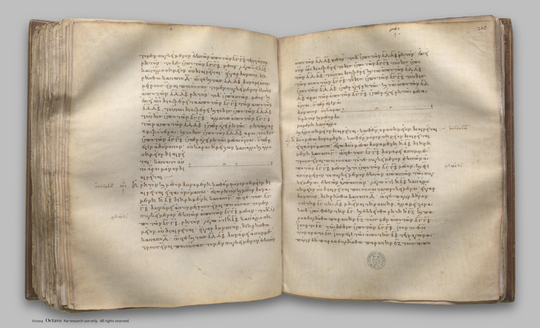index prev next | digilib folio 214

The side of the sum of two medial areas is divided at one point only.
| Ἡ δύο μέσα δυναμένη καθ' ἓν μόνον σημεῖον διαιρεῖται. Ἔστω [ δύο μέσα δυναμένη ] ἡ ΑΒ διῃρημένη κατὰ τὸ Γ, ὥστε τὰς ΑΓ, ΓΒ δυνάμει ἀσυμμέτρους εἶναι ποιούσας τό τε συγκείμενον ἐκ τῶν ἀπὸ τῶν ΑΓ, ΓΒ μέσον καὶ τὸ ὑπὸ τῶν ΑΓ, ΓΒ μέσον καὶ ἔτι ἀσύμμετρον τῷ συγκειμένῳ ἐκ τῶν ἀπ' αὐτῶν. λέγω, ὅτι ἡ ΑΒ κατ' ἄλλο σημεῖον οὐ διαιρεῖται ποιοῦσα τὰ προκείμενα. Εἰ γὰρ δυνατόν, διῃρήσθω κατὰ τὸ Δ, ὥστε πάλιν δηλονότι τὴν ΑΓ τῇ ΔΒ μὴ εἶναι τὴν αὐτήν, ἀλλὰ μείζονα καθ' ὑπόθεσιν τὴν ΑΓ, καὶ ἐκκείσθω ῥητὴ ἡ ΕΖ, καὶ παραβεβλήσθω παρὰ τὴν ΕΖ τοῖς μὲν ἀπὸ τῶν ΑΓ, ΓΒ ἴσον τὸ ΕΗ, τῷ δὲ δὶς ὑπὸ τῶν ΑΓ, ΓΒ ἴσον τὸ ΘΚ: ὅλον ἄρα τὸ ΕΚ ἴσον ἐστὶ τῷ ἀπὸ τῆς ΑΒ τετραγώνῳ. πάλιν δὴ παραβεβλήσθω παρὰ τὴν ΕΖ τοῖς ἀπὸ τῶν ΑΔ, ΔΒ ἴσον τὸ ΕΛ: λοιπὸν ἄρα τὸ δὶς ὑπὸ τῶν ΑΔ, ΔΒ λοιπῷ τῷ ΜΚ ἴσον ἐστίν. καὶ ἐπεὶ μέσον ὑπόκειται τὸ συγκείμενον ἐκ τῶν ἀπὸ τῶν ΑΓ, ΓΒ, μέσον ἄρα ἐστὶ καὶ τὸ ΕΗ. καὶ παρὰ ῥητὴν τὴν ΕΖ παράκειται: ῥητὴ ἄρα ἐστὶν ἡ ΘΕ καὶ ἀσύμμετρος τῇ ΕΖ μήκει. διὰ τὰ αὐτὰ δὴ καὶ ἡ ΘΝ ῥητή ἐστι καὶ ἀσύμμετρος τῇ ΕΖ μήκει. καὶ ἐπεὶ ἀσύμμετρόν ἐστι τὸ συγκείμενον ἐκ τῶν ἀπὸ τῶν ΑΓ, ΓΒ τῷ δὶς ὑπὸ τῶν ΑΓ, ΓΒ, καὶ τὸ ΕΗ ἄρα τῷ ΗΝ ἀσύμμετρόν ἐστιν: ὥστε καὶ ἡ ΕΘ τῇ ΘΝ ἀσύμμετρός ἐστιν. καί εἰσι ῥηταί: αἱ ΕΘ, ΘΝ ἄρα ῥηταί εἰσι δυνάμει μόνον σύμμετροι: ἡ ΕΝ ἄρα ἐκ δύο ὀνομάτων ἐστὶ διῃρημένη κατὰ τὸ Θ. ὁμοίως δὴ δείξομεν, ὅτι καὶ κατὰ τὸ Μ διῄρηται. καὶ οὐκ ἔστιν ἡ ΕΘ τῇ ΜΝ ἡ αὐτή: ἡ ἄρα ἐκ δύο ὀνομάτων κατ' ἄλλο καὶ ἄλλο σημεῖον διῄρηται: ὅπερ ἐστὶν ἄτοπον. οὐκ ἄρα ἡ δύο μέσα δυναμένη κατ' ἄλλο καὶ ἄλλο σημεῖον διαιρεῖται: καθ' ἓν ἄρα μόνον [ σημεῖον ] διαιρεῖται. | The side of the sum of two medial areas is divided at one point only. Let AB be divided at C, so that AC, CB are incommensurable in square and make the sum of the squares on AC, CB medial, and the rectangle AC, CB medial and also incommensurable with the sum of the squares on them; I say that AB is not divided at another point so as to fulfil the given conditions. For, if possible, let it be divided at D, so that again AC is of course not the same as BD, but AC is supposed greater; let a rational straight line EF be set out, and let there be applied to EF the rectangle EG equal to the squares on AC, CB, and the rectangle HK equal to twice the rectangle AC, CB; therefore the whole EK is equal to the square on AB. [II. 4 ] Again, let EL, equal to the squares on AD, DB, be applied to EF; therefore the remainder, twice the rectangle AD, DB, is equal to the remainder MK. And since, by hypothesis, the sum of the squares on AC, CB is medial, therefore EG is also medial. And it is applied to the rational straight line EF; therefore HE is rational and incommensurable in length with EF. [X. 22 ] For the same reason HN is also rational and incommensurable in length with EF. And, since the sum of the squares on AC, CB is incommensurable with twice the rectangle AC, CB, therefore EG is also incommensurable with GN, so that EH is also incommensurable with HN. [VI. 1 , X. 11 ] And they are rational; therefore EH, HN are rational straight lines commensurable in square only; therefore EN is a binomial straight line divided at H. [X. 36 ] Similarly we can prove that it is also divided at M. And EH is not the same with MN; therefore a binomial has been divided at different points: which is absurd. [X. 42 ] |